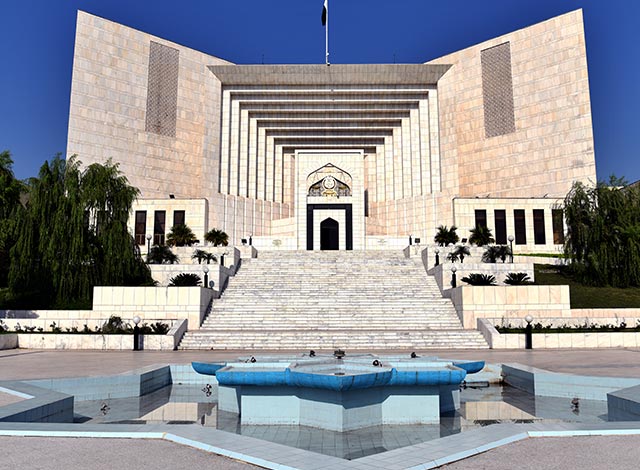The Supreme Court of Pakistan is the highest appellate court of the country and court of last resort. It is the final arbiter of the law and the Constitution. Its orders/decisions are binding on all other courts in the country. All executive and judicial authorities are bound to act in aid of the Supreme Court. The Constitution contains elaborate provisions on the composition, jurisdiction, powers and functions of the Court. The qualifications for and mode of appointment of judges, the age of retirement, the grounds and procedure for removal and the terms and conditions of service of judges are elaborately prescribed. The Supreme Court exercises original, appellate and review jurisdiction. It possesses exclusive original jurisdiction for the settlement of intergovernmental disputes between Federal and Provincial Government(s) or Provincial Governments inter se. Under this jurisdiction, the Court pronounces declaratory judgments.

The Supreme Court can also exercise original jurisdiction, with respect to the enforcement of fundamental rights, if the case involves an issue of public importance. The Court also exercises advisory jurisdiction, where under the President may obtain its opinion on a question of law. Under its appellate jurisdiction, the Court entertains appeals against orders and decisions of High Courts and other special courts/tribunals.
The Constitution provides for the independence of judiciary and its separation from the executive. The Constitution assigns the Supreme Court a unique responsibility of maintaining harmony and balance between the three pillars of the State, namely, the Legislature, the Executive and the Judiciary. As guardian of the Constitution, the Court is required to preserve, protect and defend this basic document.
The Supreme Court was created under the Constitution of 1956. It succeeded the Federal Court, set up in 1948, which was successor to the Federal Court of India, established in 1937. Since its creation in 1956, the Supreme Court has retained its name and jurisdiction through the successive legal instruments including the Constitution of 1973.
The Constitution of 1956 provided that the Supreme Court shall sit in Karachi and at such other place as the Chief Justice of Pakistan, with the approval of the President may decide. The Court was housed initially at Karachi but later on shifted to Lahore and housed in the High Court building. The 1973 Constitution provided for the permanent seat of the Court at Islamabad. The non-availability of funds however prevented the construction of the building. The Court shifted in 1974 from Lahore to Rawalpindi and was housed in an improvised building called East Pakistan House. In 1989, funds were allocated for the new building at Islamabad and construction started in 1990. The work was completed and on 31st December 1993, the Court shifted to its new premises in Islamabad.
The present building is a majestic addition on the Constitution Avenue in the Federal Capital. Its white marbled facade depicts the strength of the institution to uphold the principles of rule of law and constitutionalism in the country. The open book front elevation reflects a unique synthesis of Islamic and Japanese architectural tradition emphasizing the importance of education, transparency and equality before law as avowed objectives of the judicial organ of the State of Pakistan. The Court also has branch registries at each of the four provincial headquarters. Cases are filed at principal seat and/or branch registries. Benches of the Court rotate between the principal seat and branch registries to dispose of cases. With wide/broad jurisdiction of the Court, it is a great relief to the litigant parties to have easy and convenient access to justice, closer to home town.

